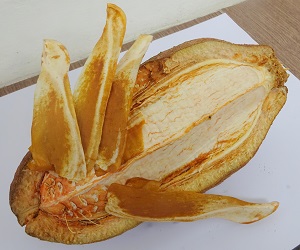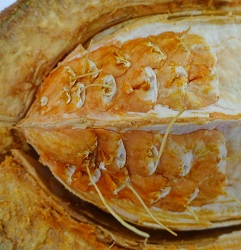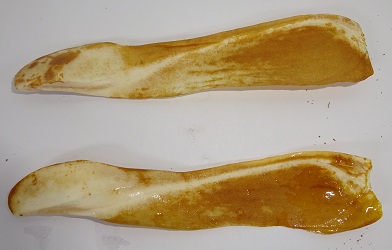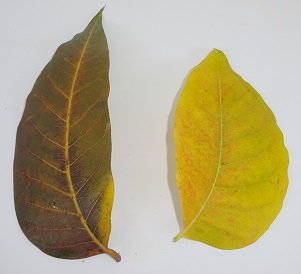| Home | Nature Weekly Index |
28 February 2016 | Big-leaf Mahogany | Swietenia macrophylla |
The Big-leaf Mahogany trees or Sky Fruit (Swietenia macrophylla) planted at the carpark area near my home were fruiting recently. I was able to see the elongated woody fruit capsules on the trees at a distance from the window of my bedroom. Probably due to strong wind and rain, some semi-matured fruit capsules had dropped to the ground and I brought one home 2 weeks ago for a closer look. Part of the brown capsule had split open and exposed some winged seeds still attached to the inner part of the capsule.



The winged seed can be divided into 2 parts; the narrow end that houses the seeds and the wing that extended to the other
broader end. In the capsule, the winged seeds are arranged in a way that the seed part is located at the base of the
capsule while the tip of the wing is attached to the apical part.
 There are fibre-like
structures at the apical region that attached to the wing part of the seed. When the winged seeds matured, the fibre will
break to release the winged seeds. The seed then dropped with its wing spinning like the rotor blades of the helicopter.
With the helpe of wind, the seed can then be dispersed at a distance away from the parent tree. In Singapore, the BES
group had reported the sighting of
parakeets (a type of parrots) feeding on the seeds of the tree.
There are fibre-like
structures at the apical region that attached to the wing part of the seed. When the winged seeds matured, the fibre will
break to release the winged seeds. The seed then dropped with its wing spinning like the rotor blades of the helicopter.
With the helpe of wind, the seed can then be dispersed at a distance away from the parent tree. In Singapore, the BES
group had reported the sighting of
parakeets (a type of parrots) feeding on the seeds of the tree.
This fast-growing tropical tree is native to Central and South America but is widely planted in Singapore, mainly along roadside and carpark area. It was introduced into Malaya in 1876. In some Southeast Asia countries, it is cultivated for its high-quality wood. Under favourable condition, the tree can reach a height of 60 metres. Its compound leaf usually end with two terminal leaflets (paripinnate). Leaflets are asymmetrical.
Besides its useful timber, the tree is also touted for its value in herbal-based traditional medical practice (phytomedicine). In Malaysia and Indonesia, the seeds are used traditionally to treat hypertension, diabetes, relieve pain, and malaria [1]. There are plenty of publications related to its potential medicinal uses, especially on its seeds, leaves and bark.
References:
[1] Moghadamtousi SZ, Goh BH, Chan CK, Shabab T, Kadir HA. Biological activities and phytochemicals of Swietenia macrophylla King. Molecules 2013;18:10465-10483. | Read article |